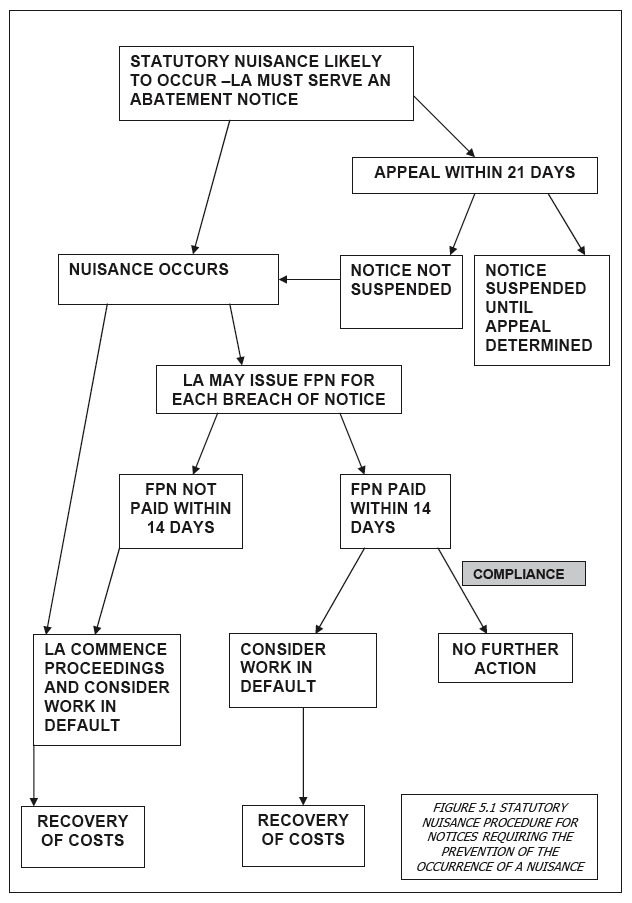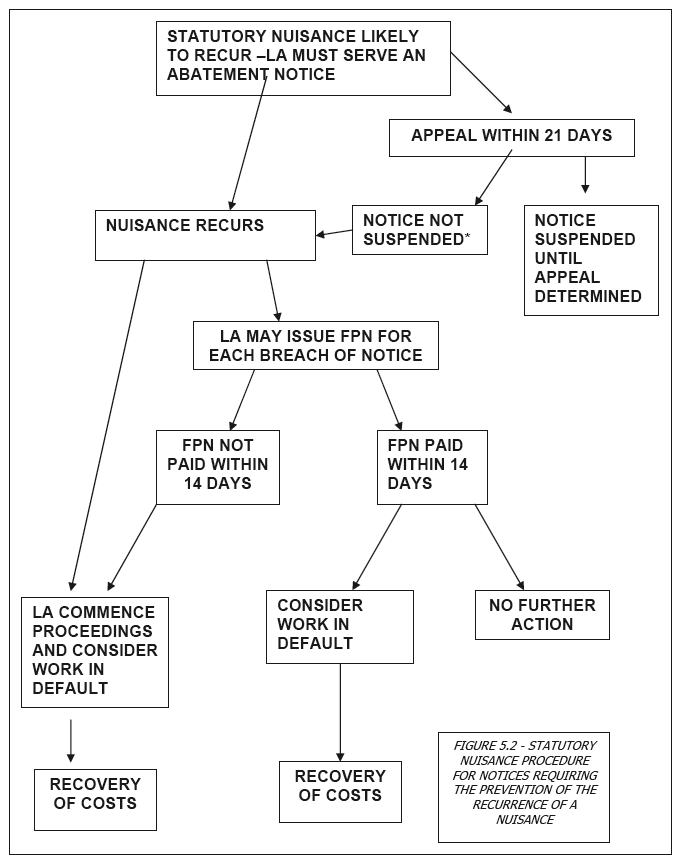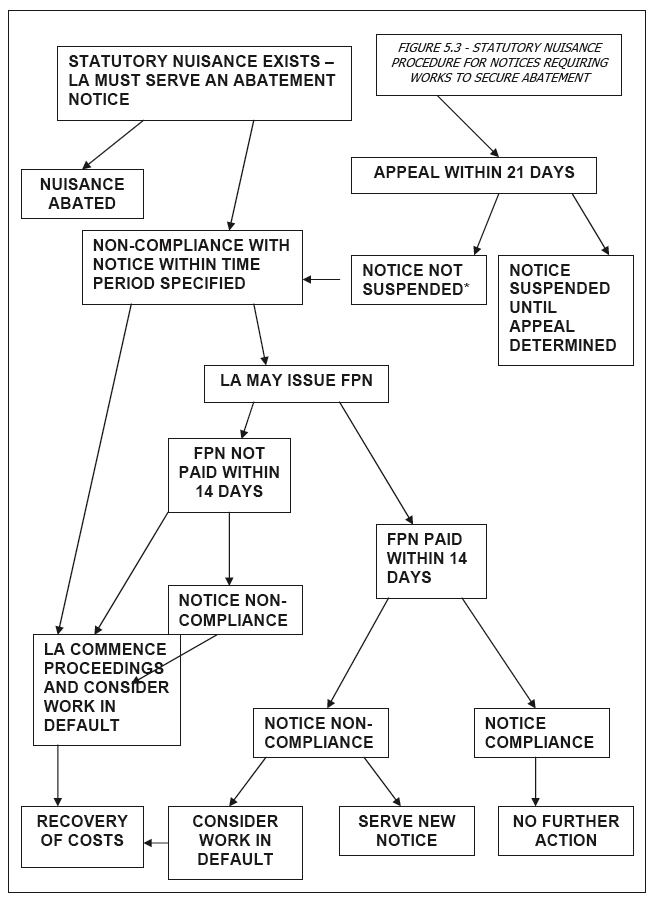Nuisance provisions of the Public Health etc (Scotland) Act 2008: guidance
Procedural guidance on the statutory nuisance provisions outlined in the Public Health etc. (Scotland) Act 2008.
8.0 - FIXED PENALTY NOTICE PROVISIONS
8.1 The new provisions for the issue of fixed penalty notices are included in section 113 of the 2008 Act. These controls are implemented by amendment of the 1990 Act. The provisions are as follows:-
113 Enforcement of statutory nuisances: fixed penalty notice
(1) The 1990 Act is further amended as follows.
(2) In section 80 (summary proceedings for statutory nuisances), after subsection (4), insert-
"(4A) Where a local authority have reason to believe that a person has committed an offence under subsection (4) above, the local authority may give that person a notice (a "fixed penalty notice") in accordance with section 80ZA offering the person the opportunity of discharging any liability to conviction for that offence by payment of a fixed penalty.".
(3) After that section, insert-
" 80ZA Fixed penalty notice: supplemental
(1) This section applies to a fixed penalty notice given under section 80(4A).
(2) A fixed penalty notice must give reasonable particulars of the circumstances alleged to constitute the offence.
(3) A fixed penalty notice must also state-
(a) the amount of the fixed penalty;
(b) the period within which it may be paid;
(c) the-
(i) person to whom; and
(ii) address at which,
payment may be made;
(d) the method or methods by which payment may be made;
(e) the consequences of not making a payment within the period for payment.
(4) The amount of the fixed penalty under section 80(4A) is-
(a) in the case of a nuisance relating to industrial, trade or business premises, £400;
(b) in any other case, £150.
(5) The period for payment of the fixed penalty is 14 days beginning with the day after the day on which the notice is given.
(6) The local authority may extend the period for paying the fixed penalty in any particular case if they consider it appropriate to do so by sending notice to the person to whom the fixed penalty notice was given.
(7) No proceedings for an offence under section 80(4) may be commenced before the end of the period for payment of the fixed penalty.
(8) In proceedings for an offence under section 80(4), a certificate which-
(a) purports to be signed by or on behalf of a person having responsibility for the financial affairs of the local authority; and
(b) states that payment of the amount specified in the fixed penalty notice was or was not received by the expiry of the period within which that fixed penalty may be paid,
is sufficient evidence of the facts stated.
(9) Where proceedings for an offence in respect of which a fixed penalty notice has been given are commenced, the notice is to be treated as withdrawn.
(10) Any sum received by a local authority under section 80(4A) accrues to that authority.
(11) The Scottish Ministers may, by regulations-
(a) provide that fixed penalty notices may not be given in such circumstances as may be prescribed;
(b) provide for the form of a fixed penalty notice;
(c) provide for the method or methods by which fixed penalties may be paid;
(d) modify subsection (4)(a) or (b) above so as to substitute a different amount (not exceeding level 2 on the standard scale) for the amount for the time being specified there;
(e) provide for the amount of the fixed penalty to be different in different cases or descriptions of case;
(f) modify subsection (5) above so as to substitute a different period for the period for the time being specified there;
(g) provide for the keeping of accounts, and the preparation and publication of statements of account relating to fixed penalties under section 80(4A).
(12) Before making regulations under subsection (11) above, the Scottish Ministers must consult, in so far as it is reasonably practicable to do so, the persons mentioned in subsection (13) below.
(13) Those persons are-
(a) such associations of local authorities; and
(b) such other persons,
as the Scottish Ministers consider appropriate.".
(4) In section 81 (supplementary provisions), for subsection (3), substitute-
"(3) Where an abatement notice has not been complied with, the local authority may, whether or not-
(a) proceedings have been taken for an offence under section 80(4); or
(b) a fixed penalty notice has been given under section 80(4A) in respect of that offence (regardless of whether the fixed penalty notice is accepted),
abate the nuisance and do whatever may be necessary in execution of the abatement notice.".
8.2 It was clear from comments received during consultation on the Public Health Bill that the relatively complex and time consuming enforcement procedures under Part III of the 1990 Act for nuisance cases was not wholly effective and that there were relatively few cases dealt with by the criminal justice system. There was a perception among local authorities that the system did not provide an adequate deterrent against offending. The creation of a fixed penalty notice for lower level offences seems an appropriate method for resolving many statutory nuisance cases.
8.3 The fixed penalty regime follows a similar procedure to other fixed penalty schemes used for environmental offences. It will assist in minimising resource-intensive litigation in a number of cases by providing a fast, flexible deterrent. The fixed penalty is a voluntary system of enforcement.
8.4 Fixed penalty notices do not alter the requirement for local authorities to serve an abatement notice. It is a statutory requirement for local authorities to specify in abatement notices an indication of the consequences of non-compliance with the requirements of an abatement notice. The new provisions similarly require that a fixed penalty notice indicate to the recipient the consequences if they fail to pay the fixed penalty within the specified time period.
8.5 The use of a fixed penalty will not be suitable in every instance and therefore it is a matter for the local authority to determine where the fixed penalty will be used.
8.6 There will be circumstances in which the local authority will wish to seek a prosecution under the 1990 Act. However, it is anticipated that in the vast majority of cases, local authorities will in the first instance offer a fixed penalty for non-compliance with the requirements of an abatement notice and that recourse to the existing enforcement proceedings will be the exception to the rule, reserved for exceptional or persistent cases of non-compliance.
8.7 The offence under section 80(4) of the 1990 Act is failure to comply with or to contravene the abatement notice (rather than causing the statutory nuisance itself). A fixed penalty notice may be offered by the local authority in respect of the particular offence and should (amongst other things) give reasonable particulars of the circumstances of the alleged offence. If the fixed penalty is not paid within the specified time, the local authority may seek prosecution for the original offence of breaching the abatement notice.
8.8 Once the fixed penalty notice is issued, enforcement proceedings cannot be commenced until the 14-day period has expired without payment of the penalty. If the fixed penalty is paid within the 14-day period then liability for that particular offence (that particular breach of the abatement notice) has been discharged and the local authority cannot seek prosecution in respect of that offence even if the nuisance is not subsequently abated.
8.9 If the fixed penalty notice is paid but the nuisance remains unabated the local authority may take action as outlined in paragraph 8.12 below to abate the outstanding nuisance. However, depending on the terms of the original abatement notice, it may be necessary for the local authority to issue a new abatement notice to ensure that further enforcement action is possible.
8.10 It is also possible that a nuisance could recur after payment of a fixed penalty. Depending on the terms of the original abatement notice, it may not be possible to take further enforcement action under the same abatement notice. It may be necessary for the local authority to issue a subsequent abatement notice to ensure that further enforcement action is possible.
8.11 If a subsequent abatement notice is served and then breached, the local authority has the option of offering a fixed penalty notice in respect of that offence (although the local authority may wish to question whether a second fixed penalty notice is likely to prove more effective than the first at securing compliance with the abatement notice). As with the first abatement notice, an alternative to the fixed penalty notice would be prosecution.
8.12 Where a breach of an abatement notice has occurred, the local authority may take action to abate the outstanding nuisance and recover the costs of doing so from the person whose act or default caused the nuisance. This power applies irrespective of whether a fixed penalty has been paid (or indeed whether or not proceedings have been taken in respect of an offence).
8.13 The circumstances that may occur and the process flow sheets for dealing with each case are:-
a) A notice is served requiring the prevention of an occurrence of a nuisance (see Figure 5.1)
b) A notice is served requiring the prevention of the recurrence of a nuisance (see Figure 5.2)
c) A notice is served requiring works to abate the nuisance (see Figure 5.3)
d) A notice is served requiring works to abate the nuisance and prevent the recurrence of the nuisance (effectively follow Figure 5.3 to secure abatement and subsequently Figure 5.2 to ensure recurrence is prevented).
FIGURE 5.1 STATUTORY NUISANCE PROCEDURE FOR NOTICES REQUIRING THE PREVENTION OF THE OCCURRENCE OF A NUISANCE

*where the nuisance is either injurious to health, where suspension would make the notice of no effect or where the benefits outweigh the costs of compliance
FIGURE 5.2 - STATUTORY NUISANCE PROCEDURE FOR NOTICES REQUIRING THE PREVENTION OF THE RECURRENCE OF A NUISANCE

*where the nuisance is either injurious to health, where suspension would make the notice of no effect or where the benefits outweigh the costs of compliance
FIGURE 5.3 - STATUTORY NUISANCE PROCEDURE FOR NOTICES REQUIRING WORKS TO SECURE ABATEMENT

*where the nuisance is either injurious to health, where suspension would make the notice of no effect or where the benefits outweigh the costs of compliance
8.14 At present the fixed penalties are £400 in respect of industrial, trade or business premises and £150 for all other cases. There are regulation-making powers available to Scottish Ministers to review these penalties in light of experience.
8.15 Where an abatement notice is served on more than one person, a fixed penalty may be offered to one or more of those persons. Where any person does not accept an offer of a fixed penalty or fails to pay within the time allotted, the local authority may take seek a prosecution further to section 80(4) of the 1990 Act.
8.16 Any fixed penalty notice must contain-
(a) reasonable particulars of the circumstances alleged to constitute the offence;
(b) the period within which the payment must be made;
(c) the amount of the fixed penalty;
(d) the person to whom and the address at which the fixed penalty may be paid (ie, the local authority which issued the abatement notice)
(e) the methods by which the payment may be made;
(f) the consequence of not making the payment within the period for payment.
8.17 The local authority can extend the period for payment of the fixed penalty (it is set at 14 days by section 80ZA(5) of the 1990 Act) and it is suggested that this may only be appropriate where there are special circumstances (and in any case only after discussion with the person responsible). The time period should not be extended as a matter of routine but likewise, extension should be unreasonably withheld where there are extenuating circumstances.
8.18 The following are some issues to be considered by local authorities is respect of the use of fixed penalty notices:-
a) The fixed penalty route may be a particularly useful alternative to prosecution where there are discrete events of recurring nuisances such as noisy parties as (depending on the terms of the abatement notice) a fixed penalty may be issued for each breach of the abatement notice.
b) In any case where a number of fixed penalty notices have been issued there should be a review to determine whether additional action may be necessary.
c) Where eventual compliance is likely but there are delays in securing compliance action the fixed penalty route may be applicable.
d) The fixed penalty route is particularly suitable for lower level offences such as small accumulations of waste.
e) It is anticipated that the fixed penalty route would not be used where a statutory nuisance exists due to a prejudice to health as in this case there may be unacceptable health consequences inherent in any delay caused by payment of the penalty but no abatement of the nuisance.
f) The fixed penalty may be appropriate for notices requiring prevention of nuisance such as noise from commercial premises
g) It should be remembered that there are no defences in connection with a fixed penalty notice as they are voluntary measures.
8.19 The local authority is able to keep any income from fixed penalty fines to enable it to reinvest in their area, similar to the anti-social behaviour noise fixed penalty scheme. However, in line with the new financial arrangements that came into force in April 2008, it is for local authorities to decide whether the income will be retained in the service area responsible for nuisance or be used for other purposes.
8.20 The following is an example of a statutory nuisance fixed penalty notice.
NOTICE REF: 090101FPN
ANYWHERE COUNCIL
ENVIRONMENT SERVICES
STATUTORY NUISANCE OFFENCE
NOTICE OF OPPORTUNITY TO PAY FIXED PENALTY
ENVIRONMENTAL PROTECTION ACT 1990 AS AMENDED BY PUBLIC
HEALTH
ETC (SCOTLAND) ACT 2008
Alleged Offender-Name:
Billy Nuisance.
Address:
47 High Street, Anywhere, AX4 8XA
I, Philip Inspector an authorised Officer of Anywhere Council hereby give you notice, in terms of Section 80(4A) of the above Act that at 47 High Street, Anywhere, AX4 8XA, a statutory nuisance, as defined in Section 79(1)(e) of the said Act, exists and is likely to recur, arising from accumulation of waste animal faeces in the rear yard at 14.30 hours on 10 February 2009 in contravention of the Abatement Notice Reference 090101 dated 10 January 2009
This notice offers you the opportunity of discharging any liability to conviction for the offence by paying a fixed penalty of £150 no later than 24 February 2009. Payment should be made to The Director of Finance, Anywhere Council, Civic Offices, Main Street, Anywhere, AX8 4XA and payment can be made by cash, cheque or debit card in person at the above address or you can send a cheque or postal order (payable to "Anywhere Council") together with a contact telephone number, a note of your name and address and either the completed Fixed Penalty Notice return below or the Fixed Penalty Notice number.
Failure to pay the fixed penalty fee by 24 February 2009 will result in the case being referred to the Procurator Fiscal seeking prosecution. Failure to comply with an abatement notice is an offence under Section 80(4) of the Act and liable on summary conviction to a fine not exceeding level 5 of the standard scale of fines to in Section 289G of the Criminal Procedure (Scotland) Act 1975, together with a further fine of one tenth of that level for each day on which the offence continues after conviction.
Failure to abate the nuisance will result in either the local authority carrying out the necessary works in accordance with section 81(3) and recovering all reasonably incurred expenses in accordance with section 81(4) or the service of a further abatement notice.
If you are not sure of your rights or the implications of this Notice, you may want to seek legal advice.
Signed: ………………………………………………………….
Date of Issue: 10 February 2009
Anywhere Council, Civic Offices, Main Street, Anywhere, AX8 4XA
TO BE COMPLETED BY RECIPENT OF FIXED PENALTY NOTICE
REF: 090101FPN
ANYWHERE COUNCIL NOTICE
ENVIRONMENT SERVICES
STATUTORY NUISANCE OFFENCE
NOTICE OF OPPORTUNITY TO PAY FIXED PENALTY
ENVIRONMENTAL PROTECTION ACT 1990 AS AMENDED BY PUBLIC
HEALTH
ETC (SCOTLAND) ACT 2008
Name
Address
I enclose payment of the appropriate fixed penalty
Signed: …………………………………………….. Date: ……………………………….
How to Pay
Payment should be made to The Director of Finance, Anywhere Council, Civic Offices, Main Street, Anywhere, AX8 4XA and payment can be made by cash, cheque or debit card in person at the above address or you can send a cheque or postal order (payable to "Anywhere Council") together with a contact telephone number, a note of your name and address and either the completed Fixed Penalty Notice return below or the Fixed Penalty Notice number.
Contact
Email: Central Enquiries Unit ceu@gov.scot
There is a problem
Thanks for your feedback